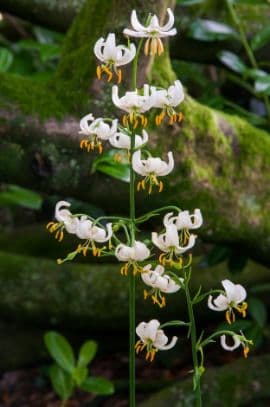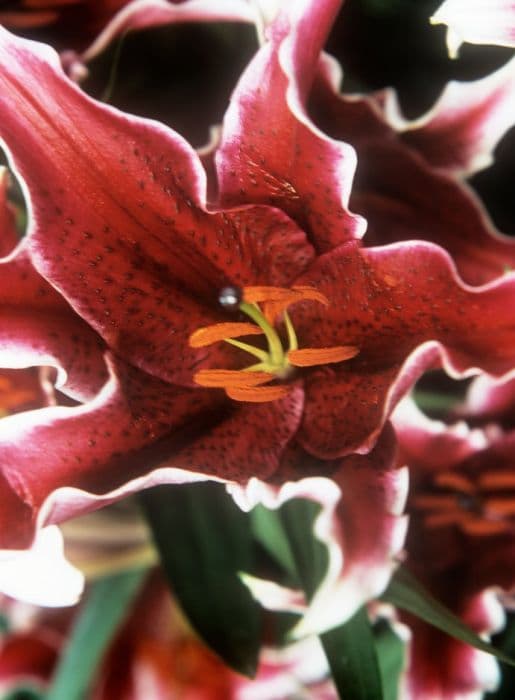Tulip Tulipa 'Fantasy' (10)

ABOUT
Tulipa 'Fantasy' is a striking variety of the commonly known tulip that boasts a captivating appearance. It features uniquely patterned flowers where each petal showcases a blend of colors, often combining shades like pink, apricot, and creamy yellow with a subtle gradient effect that gives the blooms depth and intrigue. The petals themselves are large and rounded with a slightly ruffled edge, which adds to the flower's whimsical and dreamy aesthetic. The interior of the tulip also presents a noteworthy display, with a contrasting base color often accented by a different hue. This could be a darker or lighter spot at the base of each petal, drawing attention to the flower's center. As with many tulips, the flowers sit atop a singular, sturdy stem that greens up as it nears the bloom. The leaves of Tulipa 'Fantasy' are typical of the species: they're long and strap-like with a gentle waviness and a rich green color that provides a perfect backdrop for the colorful flowers. The overall impression Tulipa 'Fantasy' creates in a garden setting is one of elegance and vibrant, painterly beauty that stands out during its blooming season.
About this plant
 Names
NamesFamily
Liliaceae.
Synonyms
Tulip.
Common names
Tulipa 'Fantasy'.
 Toxicity
ToxicityTo humans
Tulip 'Fantasy' is part of the Tulip species, and while it is primarily grown for ornamental purposes, it can have toxic effects if ingested by humans. These effects are due to compounds known as tulipalin A and B. If a person consumes part of a tulip, they may experience symptoms such as nausea, vomiting, diarrhea, and abdominal pain. In some cases, handling or cutting tulip bulbs can also cause allergic reactions in sensitive individuals, leading to skin irritation. Though serious complications are rare, it is important to keep tulip bulbs and plants out of reach from children who might accidentally ingest them.
To pets
Tulip 'Fantasy', commonly referred to as just Tulip, can be toxic to pets, particularly cats and dogs, if ingested. The plant contains allergenic lactones or similar alkaloids, especially concentrated in the bulbs. If a pet chews on or eats any part of a tulip, but primarily the bulb, they can experience symptoms such as oral irritation, drooling, vomiting, or diarrhea. In some cases, a larger ingestion could potentially lead to more severe symptoms such as increased heart rate and difficulty breathing. If you suspect your pet has eaten part of a tulip plant, it is important to contact a veterinarian immediately.
 Characteristics
CharacteristicsLife cycle
Perennials
Foliage type
Deciduous
Color of leaves
Green
Flower color
Pink
Height
1.5 feet [45 cm]
Spread
6 inches [15 cm]
Plant type
Bulb
Hardiness zones
3
Native area
Central Asia
Benefits
 General Benefits
General Benefits- Enhances Garden Aesthetics: Adds a pop of color with its striking blooms.
- Attracts Pollinators: Invites bees and butterflies, promoting biodiversity.
- Easy to Grow: Requires minimal maintenance once established.
- Spring Bloomer: One of the first flowers to bloom, signaling the end of winter.
- Great for Cut Flowers: Lasts long in vases, brightening indoor spaces.
- Versatile Planting: Suitable for beds, borders, and container gardening.
- Drought Resistant: Once established, it can tolerate periods of dryness.
- Symbolic Meaning: Often associated with perfect love and prosperity.
- Perennial Growth: Returns year after year with proper care.
- Deer-Resistant: Less likely to be eaten by deer compared to other plants.
 Medical Properties
Medical PropertiesThis plant is not used for medical purposes.
 Air-purifying Qualities
Air-purifying QualitiesThis plant is not specifically known for air purifying qualities.
 Other Uses
Other Uses- The tulip petals can be used as a natural colorant for fabrics, giving clothes a soft, pink hue when used in the dyeing process.
- Crushed tulip petals can be mixed with clear glue to create a decorative, floral adhesive for paper crafts or scrapbooking.
- Tulip petals can be added to homemade soaps for fragrance and to create an attractive floral appearance.
- The sturdy stems of tulips can be used as a natural support for other, more delicate flowers in mixed floral arrangements.
- Dried tulip petals can serve as a component in potpourri mixes, contributing color and a light, spring-like scent.
- When candied, tulip petals become edible decorations for desserts like cupcakes, cakes, and delicate pastries.
- The bulbs of tulips, when properly cleaned and prepared, can be ground into a paste and used as a natural adhesive or binding agent in certain recipes.
- Tulip flowers can be hollowed out and used as a biodegradable cup or holder for small appetizers or desserts at eco-friendly events.
- Water infused with tulip petals can be used as a scented rinse for linens, imparting a fresh, floral aroma.
- The shape and structure of tulip petals can inspire patterns and designs in art, fashion, and jewelry, serving as a muse for creative projects.
Interesting Facts
 Feng Shui
Feng ShuiThe tulip is not traditionally used in Feng Shui practice.
 Zodiac Sign Compitability
Zodiac Sign CompitabilityThe tulip is not used in astrology practice.
 Plant Symbolism
Plant Symbolism- Love: The tulip is often associated with perfect love and deep affection, symbolizing the heart being aflame with love.
- Rebirth: Tulips bloom in the spring, making them symbols of rebirth and new beginnings, pertinent to their appearance after the winter season.
- Variety: Due to the wide range of colors available, tulips can represent diversity and abundance.
- Elegance: The distinct cup-shaped flowers and graceful stems give tulips an air of elegance and sophistication.
- Temporary Bliss: As tulips are not long-lasting flowers, they can represent the transient nature of happiness and the fleeting moments of joy.
 Water
WaterTulips, including the Tulip 'Fantasy', should be watered deeply when they are in active growth and the soil feels dry to the touch, typically once a week. Ensure the soil is well-draining to avoid waterlogging the bulbs. During the growing season, provide about 1 gallon of water per square foot every week, unless there has been significant rainfall. Watering in the early morning is ideal to allow moisture on leaves to dry before nightfall. After the tulips have bloomed and the leaves start to yellow, gradually reduce watering to allow the plant to enter dormancy.
 Light
LightTulips including Tulip 'Fantasy' require full sun to perform best. They should be planted in an area that receives at least six hours of direct sunlight each day. Avoid areas that are shaded for most of the day or have filtered light, as this can lead to weak growth and fewer blooms.
 Temperature
TemperatureTulips such as Tulip 'Fantasy' thrive in a climate with cool winters and warm springs. They can survive winter temperatures as low as 14°F and are generally planted in the fall so they can chill during the winter months, which is necessary for bulb development. The ideal temperature for tulip growth is between 60°F and 70°F during their active growing season in the spring.
 Pruning
PruningTulip 'Fantasy' should have its flowers deadheaded after they fade to prevent seed production, which can drain energy from the bulb. Leaves should be left in place until they turn yellow and die back naturally, as they are photosynthesizing to gather energy for next year's growth. Pruning of leaves should only occur when they have turned yellow entirely, usually a few weeks after blooming.
 Cleaning
CleaningAs needed
 Soil
SoilTulips require well-draining soil with a slightly acidic to neutral pH of 6.0 to 7.0. The best soil mix for Tulips should include a balanced blend of loamy garden soil, compost, and sand to ensure proper drainage and fertility.
 Repotting
RepottingTulips, being perennial bulbs, do not need annual repotting. However, after the flowering has ended and the foliage has died back, you can lift the bulbs and store them in a cool, dry place and then replant them in the fall.
 Humidity & Misting
Humidity & MistingTulips prefer average humidity levels and do not require any special humidity considerations; typical outdoor ambient humidity is suitable for these plants.
 Suitable locations
Suitable locationsIndoor
Ensure bright light, cool temperatures, and well-draining soil for indoor Tulips.
Outdoor
Plant bulbs in fall, full sun to part shade, in well-draining soil.
Hardiness zone
3-8 USDA
 Life cycle
Life cycleTulipa 'Fantasy', commonly known as the Fantasy Tulip, begins its life as a bulb, which undergoes a period of dormancy typically in the late summer and fall. As temperatures warm in the spring, the bulb breaks dormancy and sprouts, sending up leaves and a single stem. The plant then blooms, producing its distinctive flowers, which can vary in color depending on the variety. After blooming, the flowers will fade and the plant will divert energy into replenishing the bulb for the next season. The foliage of the tulip eventually dies back as the plant enters another period of dormancy during the summer months. The cycle repeats each year with bulbs potentially multiplying, which can be separated and replanted to propagate new plants.
 Propogation
PropogationPropogation time
Early Autumn
Propogation: Tulips, including the 'Fantasy' variety, are most commonly propagated through the division of their bulbs. The optimal time to propagate tulip bulbs is in the fall, when temperatures start to cool down but before the ground freezes. The process involves gently digging up the mature bulbs after the foliage has withered post-bloom in late spring or early summer. These bulbs are then stored in a cool, dry place until the fall planting season. One should carefully separate the smaller offset bulbs, which are also called bulblets, from the base of the mother bulb. These offsets, once replanted in well-drained soil at a depth of roughly 6 to 8 inches (approximately 15 to 20 centimeters), will grow and eventually flower in the following spring, given they have developed sufficiently. It is critical to provide adequate space between the bulbs to ensure proper growth, usually around 4 to 6 inches apart (10 to 15 centimeters).




![Lily [Roselily Chelsea]](/_next/image?url=https%3A%2F%2Fplants-admin.emdemapps.com%2Fimages%2Fplants%2F%2Fimages%2F604b584f6f830.png&w=640&q=75)




